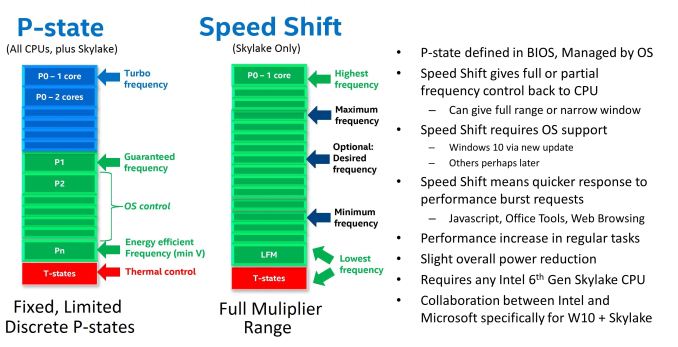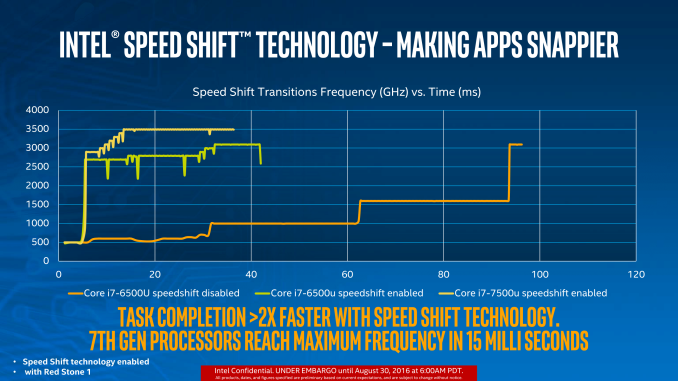The Intel Core i3-7350K (60W) Review: Almost a Core i7-2600K
by Ian Cutress on February 3, 2017 8:00 AM EST7th Generation New Features
One of the big questions regarding the launch of Intel’s 7th Generation of CPUs was around what extra features the new platform brings, especially if there isn’t any clock-for-clock performance improvement. As with our other Kaby Lake reviews, here we explain the main two: Speed Shift v2 and Optane Memory support.
Speed Shift v2
For the Intel’s 6th Generation of processors, Skylake, they introduced Speed Shift (v1). This was a feature that, at a high level, gave control of the voltage/frequency curve from the operating system to the processor. Using a series of internal metrics, such as instruction analysis and frequency, the CPU would automatically adjust the voltage and frequency of the processor as required. This afforded two major benefits: one, with the CPU in control it has access to many more points on the curve compared to the OS which is limited to specific P-states on the processor.
The second benefit is the speed of transition. A processor that can ramp up to a high frequency quickly and then drop down as needed can get through instructions quicker but also save power. Imagine driving a car, and having to wait 60 seconds to change a gear – it’s that sort of analogy.
What Speed Shift v2 does in the Kaby Lake family, compared to v1 in Skylake, is manage those transitions to higher frequency faster. Before Speed Shift, transitions from idle to peak turbo were on the order of 100 milliseconds, and Speed Shift v1 took that to 30 milliseconds (with a good base established within 15). Speed Shift v2 means that peak performance from idle now happens in 10-15 milliseconds total. This means that interactions with the OS, such as touch, or actions that rely on low latency, can occur within a couple of frames on a 60 Hz display.
The benefit of Speed Shift lies a lot in touch devices, which perhaps doesn’t affect the desktop Kaby Lake processors in this review, but also in web interactions. A lot of web work is stop and start, such as scrolling or javascript functions.
There is one caveat however – Speed Shift currently only works in Windows 10. It requires a driver which is automatically in the OS (v2 doesn’t need a new driver, it’s more a hardware update), but this limitation does mean that Linux and macOS do not benefit from it. I would be hard pressed to not imagine that Apple and Intel were not working on a macOS driver, but as yet we have not had confirmation that one exists.
Optane Memory Support
The latest memory technology to hit prime time is Intel and Micron’s 3D XPoint. This is a non-volatile form of data storage that is bit addressable and can be used as DRAM or storage. Despite being at least a decade in the making, and being formally announced in 2014, it is still yet to show up commercially as it is still being developed. Intel plans to create 3D XPoint DRAM that is slightly slower than normal DRAM but both denser (more of it) and non-volatile (keeps the data after power loss, saves power altogether), as well as 3D XPoint Storage that is faster than standard NAND flash, and more configurable. It the scheme of things, we expect the storage based products to hit the market first.
Intel, as far as we can tell, is set to release two main classes of product: Optane DRAM to be pin-compatible with DDR4 and require Optane DRAM enabled processors, and Optane SSDs which should work with any PCIe storage interface. ‘Optane Memory’ however, is something a little different. Based on pre-briefings, Optane Memory is certainly not Optane SSD we were told, but rather a storage cache for mechanical hard-drives. We’ve had this before with NAND flash drives, using Intel’s Rapid Storage Technology, and it seems that Kaby Lake and 200-series chipsets will support a new version of RST for PCIe based storage. But because this is caching drive, such as the 16GB Optane Memory drives in Lenovo’s upcoming notebooks, and not Optane SSD, might lead us to believe that ‘Optane Memory’ drives are not designed to be directly user addressable.
All that being said, Intel has stated that Optane Memory standalone drives should hit the market nearer Q3 for general consumer use, which is more in-line with what we might expect to see with Optane SSDs in the enterprise space.













186 Comments
View All Comments
Flunk - Monday, February 6, 2017 - link
Yeah, that is funny. I'm using a massively overpowered PSU myself. I have a 850W unit running a system with a moderately-overclocked i7-6700k and Geforce 1070. Had it left over from my previous massively overclocked i5-2500k and dual Radeon 7970s, even if it's aged badly (which it probably hasn't it's only a few years old) it should still be good for ages, especially as under-stressed as it now is.fanofanand - Friday, February 3, 2017 - link
Or you could just get Ryzen with the wraith cooler :)BrokenCrayons - Friday, February 3, 2017 - link
Perhaps when they're available for purchase I'll look into it. I'm interested in seeing what AMD does with mobile Ryzen, integrated graphics, and HBM for CPUs (unlikely) and how it changes laptop computing.fanofanand - Friday, February 3, 2017 - link
The rumor mill has been churning and the consensus is that APU's will be available in 2018 with HBM. That will be a game changer for more than just mobile computing, but for small form factors as well. At least theoretically, experience tells me we should wait for reviews before deciding how profound the impact will be.Flunk - Monday, February 6, 2017 - link
The Wraith cooler is both marginal and loud compared to quality aftermarket coolers that cost as little as $35. Sure it's better than the last AMD stock cooler, but that's more a case of the last AMD stock cooler being total garbage.bananaforscale - Wednesday, February 8, 2017 - link
Hey, no dissing huge air coolers! :D (Yeah, I have one and it's so big it largely dictated the case selection. Does keep a hexcore Bulldozer at 52 degrees at 4 GHz tho.) There's also the niggle on Intel side that their enthusiast line has only made it to Broadwell-E, so that's what I'll be upgrading to. A huge upgrade in IPC (which probably won't rise much in the next years), more cores and lower power use per core. I figure I'll be upgrading next around 2025. :D I'm pondering whether I should go AIO liquid or custom...MonkeyPaw - Friday, February 3, 2017 - link
More emphasis is going into the IGP.CaedenV - Friday, February 3, 2017 - link
I doubt it is competition. I mean, lack of competition certainly explains the price per performance not coming down even though the manufacturing costs are getting cheaper, but I think that we have hit a performance wall.With every die shrink we can get more performance per watt... but the die is also more heat sensitive which kills stability for higher clocks. The idea that you can hit 5GHz on the new chips is nothing short of a miracle! But without a major increase in clock speed, then your performance is limited to the instruction sets and execution model... and that is much harder to change.
And that isn't hard to change because of competition. That is hard to change because PCs live and die by legacy applications. If I can't go back and play my 20 year old games every 3-4 years then I am going to get rather annoyed and not upgrade. If businesses can't run their 20 year old software every day, then they will get annoyed and not upgrade.
I think we are rather stuck with today's performance until we can get a new CPU architecture on the market that is as good as ARM on the minimum power consumption side, but as efficient as x86 on the performance per watt side... but whatever chip comes out will have to be able to emulate today's x86 technology fast enough to feel like it isn't a huge step backwards... and that is going to be hard to do!
xenol - Friday, February 3, 2017 - link
Anandtech please do frame-time tests as well for games. Average frame rate is good and all, but if the processor causes dips in games that could lead to an unpleasant experience.Mr Perfect - Friday, February 3, 2017 - link
I would also be interested in seeing this.The site slips my mind, but somewhere tested multiple generations of i7s, i5s and i3s for minimum framerate and even the oldest i7s had a more consistent framerate then the newest i3s. It would be interesting to get AT's take on this.